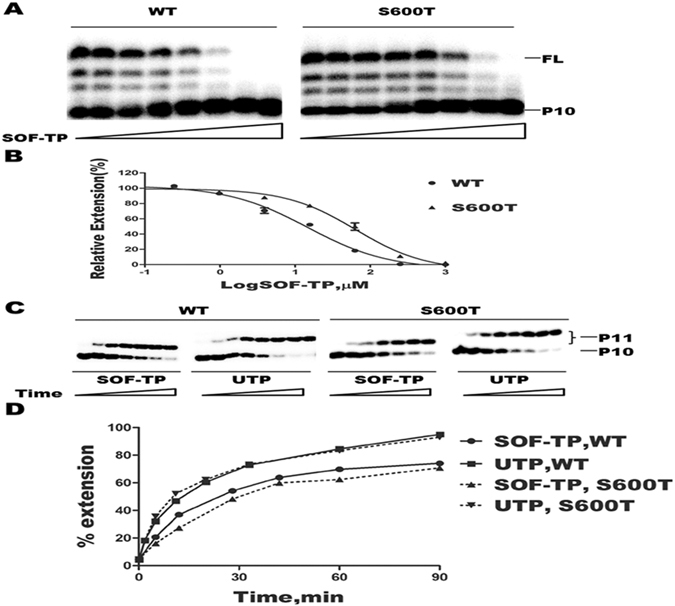Figure 4.

Inhibition of DENV NS5 RdRp activity by SOF-TP and time course of incorporation of SOF-TP or UTP in primer extension assays by DENV WT NS5 and the S600T mutant. (A) Inhibitory effect was determined by in vitro primer extension assay using purified NS5 proteins and P10/T14 RNA duplex template in RdRp assay buffer in the presence of 0.5 µM each of NTPs and variable concentrations of SOF-TP. Reaction products were analyzed by denaturing polyacrylamide gel electrophoresis (6% acrylamide, 7 M Urea). P10 and FL indicate the positions of the 5′-end radiolabelled P10 primer and full-length extension products of the primer extension reactions. (B) Dose-response curves showing inhibition by SOF-TP of the activity of DENV NS5 WT and the S600T mutant. The IC50 (50% inhibitory concentration) value was defined as the concentration of SOF-TP at which the full-length (FL) products were decreased by 50% relative to the control reaction performed in the absence of SOF-TP, and was calculated by nonlinear regression analysis: IC50WT = 14.7 ± 2.5 µM, IC50S600T = 63.8 ± 5.3 µM. The data represent the means ± standard deviation (SD) of 3 independent experiments. (C) The RNA T14 template and 5′-end radiolabeled RNA primer P10 duplex were used to assess the incorporation efficiency of UTP and SOF-TP on RNA synthesis by use of purified recombinant DENV NS5 WT and S600T mutant enzymes in time course primer extension assays over a period of 90 min. Sampling time points for UTP (min): 0.2, 2, 5, 10, 20, 30, 60, 90; SOF-TP (min): 0.2, 5, 15, 30, 45, 60, 90.P10 and P11 indicate the positions of the unextended and extended primers, respectively. (D) Quantitative analysis of UTP or SOF-TP incorporation in a time course primer extension assay. Incorporation efficiencies were compared based on the percentages of extended primer.
